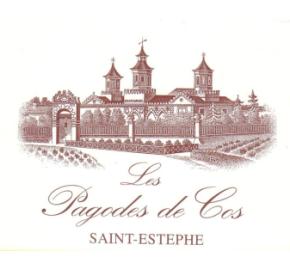
Les Pagodes de Cos 2010
- Producer Chateau Cos d'Estournel
-
Blend
62% Cabernet Sauvignon
38% Merlot - Country France
- Region Bordeaux
- Appellation Saint-Estephe
- UPC 0 15643 58159 5
Vineyard
Les Pagodes de Cos is, strictly speaking, Cos d'Estournel's "second wine". The vines that produce it are eventually used for the "Grand Vin" which is an 1855 Grand Cru Classé. They are grown on the same terroir and are treated in the same way.
They are simply younger and their roots have yet to grow to their full depth in the gravelly soil. Powerful, very aromatic, long on the palate, with a very persistent finish, Les Pagodes de Cos is a wine of refinement and pleasure, to be drunk within ten years of its bottling at the chateau.
They are simply younger and their roots have yet to grow to their full depth in the gravelly soil. Powerful, very aromatic, long on the palate, with a very persistent finish, Les Pagodes de Cos is a wine of refinement and pleasure, to be drunk within ten years of its bottling at the chateau.
Vintage
The 2010 vintage is the result of an exceptional combination of dry weather – 2010 was the driest year of the decade – and of rather cool temperatures – with the coldest May for five years.
Harvest
Merlot were harvested from September 27th to October 3rd and the Cabernet Sauvignon were harvested from October 5th to October 10th.
Viticulture
These weather conditions produced a late, extended flowering period. The flowering, which was disrupted in some instances, resulted in significant flower abortion of the Merlot. One of the consequences of this was relatively low yields.
Weather conditions in the first half of July (summer temperatures but not a heat wave), allowed the veraison, which had been slowed down, to quickly be completed.
The very low rainfall this year (fairly close to that of 2005) resulted in small berries and very well-ripened tannins.
Weather conditions in the first half of July (summer temperatures but not a heat wave), allowed the veraison, which had been slowed down, to quickly be completed.
The very low rainfall this year (fairly close to that of 2005) resulted in small berries and very well-ripened tannins.
